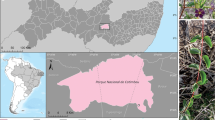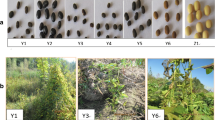Abstract
Torreya grandis is a rare tree species of economic value. Its seeds are rich in lipids, although their use is limited by their high cost. Recent studies demonstrated that certain endophytic fungi can produce metabolites similar to those produced by the host plant. In the present study, endophytic fungal strains capable of producing lipids were isolated from wild Chinese Torreya grandis. Among these, the XF-38 strain had the highest lipid content at 17.68%. Comparative analysis of the fatty acid composition of lipids produced by endophytic fungi and Torreya seeds by GC-MS showed that the two sources shared some of the same components, including linoleic acid, oleic acid, and sciadonic acid (5c, 11c, 14c-eicosatrienoic acid). The morphology and internal transcribed spacer rDNA of the XF-38 strain were determined, and a BLAST search showed that this strain belongs to Bionectria ochroleuca. Finally, generation of a growth curve and determination of the lipid content of strain XF-38 confirmed that lipid production was related to the amount of mycelium, and the lipid content resched 3.1 g/L in the microcrystalline cellulose meduim.
Similar content being viewed by others
References
Asai, T., Otsuki, S., Taniguchi, T., Monde, K., Yamashita, K., Sakurai, H., Ozeki, T., and Oshima, Y., Structures and absolute configurations of short-branched fatty acid dimers from an endophytic fungus of Aloe arborescens, Tetrahedron Lett., 2013, vol. 54, pp. 3402–3405.
Berger, A., Monnard, I., Baur, M., Charbonnet, C., Safonova, I., and Jomard, A., Epidermal anti–inflammatory properties of 5,11,14 20:3:effects on mouse ear edema, PGE2 levels in cultured keratinocytes, and PPAR activetion, Lipids Health Dis., 2002, vol. 1, pp. 1–12.
Chen, B.Q., Cui, X.Y., Zhao, X., Zhang, Y.H., Piao, H.S., Kim, J.H., Lee, B.C., Pyo, H.B., and Yun, Y.P., Antioxidative and acute antiinflammatory effects of Torreya grandis, Fitoterapia, 2006, vol. 77, pp. 262–267.
Dai, C.C., Tao, J., Xie, F., Dai, Y., and Zhao, M., Biodiesel generation from oleaginous yeast Rhodotorula glutinis with xylose assimilating capacity, Afr. J. Biotechnol., 2007, vol. 6, pp. 2130–2134.
Deng, H.H., Hong, W., Wu, C.Z., et al., Separation, selection and identification on producing lipid strains of endophytic fungi from Pinus massoniana, J. Plant Resour. Environ., 2014. vol. 23, no. 2, pp. 27–33.
Endo, Y., Osada, Y., Kimura, F., and Fujimoto, K., Effects of Japanese torreya (Torreya nuciferu) seed oil on lipid metabolism in rats, Nutrition, 2006, vol. 22, pp. 553–558.
Strobell, G.A., Knighton, B., Kluck, K., Ren, Y., Livinghouse, T., Griffin, M., Spakowicz, D., and Sears, J., The production of myco–diesel hydrocarbons and their derivatives by the endophytic fungus Gliocladium roseum (NRRL 50072), Microbiology (UK), 2008, vol. 154, pp. 3319–3328.
Samuels, G.J., Suarez, C., Solis, K., Holmes, K.A., Thomas, S.E., Ismaiel, A., and Evans, H.C., Trichoderma theobromicola and T. paucisporum: two new species isolated from cacao in South America, Mycol. Res., 2006, vol. 110, pp. 381–392.
Schmeda–Hirschmann, G., Hormazabal, E., Astudillo, L., Rodriguez, J., and Theoduloz, C., Secondary metabolites from endophytic fungi isolated from the Chilean gymnosperm Prumnopitys andina (Lleuque), World J. Microbiol. Biotechnol., 2005, vol. 21, pp. 27–32.
Guo, L.D., Hyde, K.D., and Liew, E.C.Y., Detection and taxonomic placement of endophytic fungi within frond tissues of Livistona chinensis based on rDNA sequences, Mol. Phylogenet. Evol., 2001, vol. 20, pp. 1–13.
Schroers, H.-J., Samuels, G.J., Seifert, K.A., and Gams, W., Classification of the mycoparasite Gliocladium roseum in Clonostachys as C. rosea, its relationship to Bionectria ochroleuca, and notes on other Gliocladium–like fungi, Mycologia, 1999, vol. 91, pp. 365–385.
Huang Y.J., Wang J.F., Li G.L., Zheng, G., and Su, W., Antitumor and antifungal activities in endophytic fungi isolated from pharmaceutical plants Taxus mairei, Cephalataxus fortunei and Torreya grandis, FEMS Immunol. Med. Microbiol., 2001, vol. 31, pp. 163–167.
Saeed, M.K, Deng Y.L., Dai R.J., Li, W., and Igbal, Z., Appraisal of antinociceptive and anti–inflammatory potential of extract and fractions from the leaves of Torreya grandis Fort ex. Lindl., J. Ethnopharmacol., 2010, vol. 127, pp. 414–418.
Stierle, A., Strobel, G., and Stierle, D., Taxol and taxane production by Taxomyces andreanae, an endophytic fungus of Pacific yew, Science, 1993, vol. 260, p. 214.
Tan, Q., Yan, X., Lin X, Huang, Y., Zheng, Z., Song, S., Lu, C., and Shen, Y., Chemical constituents of the endophytic fungal strain Phomopsis sp. NXZ–05 of Camptotheca acuminata, Helvet. Chim. Acta, 2007, vol. 90, pp. 1811–1817.
Tanaka, T., Morishige, J., Takimoto, T., Takai, Y., and Satouchi, K., Metabolic characterization of sciadonic acid as an effective substitute for arachidonate of phosphatidyrlinositol, Eur. J. Biochem., 2001, vol. 268, pp. 4928–4939.
Teng, Y. and Dai, C.C., Interactions of two endophytic fungi colonizing Atractylodes lancea and effects on the host’s essential oils, Acta Ecol. Sinica, 2013, vol. 33, pp. 87–93.
Vatcharin, R., Sathit, B., Souwalak, P., and Jariya, S., Amide, cyclohexenone, and cyclohexenone–sordaricin derivatives from the endophytic fungus Xylaria plebeja PSU-G30, Tetrahedron, 2003, vol. 69, pp. 10711–10717.
Wolff, R., The phylogenetic significance of sciadonic (all-cis 5,11,14-20:3) acid in gymnosperms and its quantitative significance in land plants, J. Amer. Oil Chem. Soc., 1999, vol. 76, pp. 1515–1516.
Yu, M.J., Shin, H.J., Ke, J.C., and Tzong, H.L., TMC-151 a monoacetate, a new polyketide from Bionectria ochroleuca, ChemInform, 2007, vol. 38, p. 26.
Yu, Y. and Hu, C.H., Separation and identification of a new Taxus chinensis var. mairei endophytic fungus (Bionectria sp.) and the activity of its metabolites, J. Southwest Univ. (Nat. Sci. Ed.) 2007, vol. 29, pp. 131–135.
Author information
Authors and Affiliations
Corresponding author
Additional information
The article is published in the original.
Rights and permissions
About this article
Cite this article
Yang, Y., Jin, Z., Jin, Q. et al. Isolation and fatty acid analysis of lipid-producing endophytic fungi from wild Chinese Torreya Grandis . Microbiology 84, 710–716 (2015). https://doi.org/10.1134/S0026261715050173
Received:
Published:
Issue Date:
DOI: https://doi.org/10.1134/S0026261715050173




